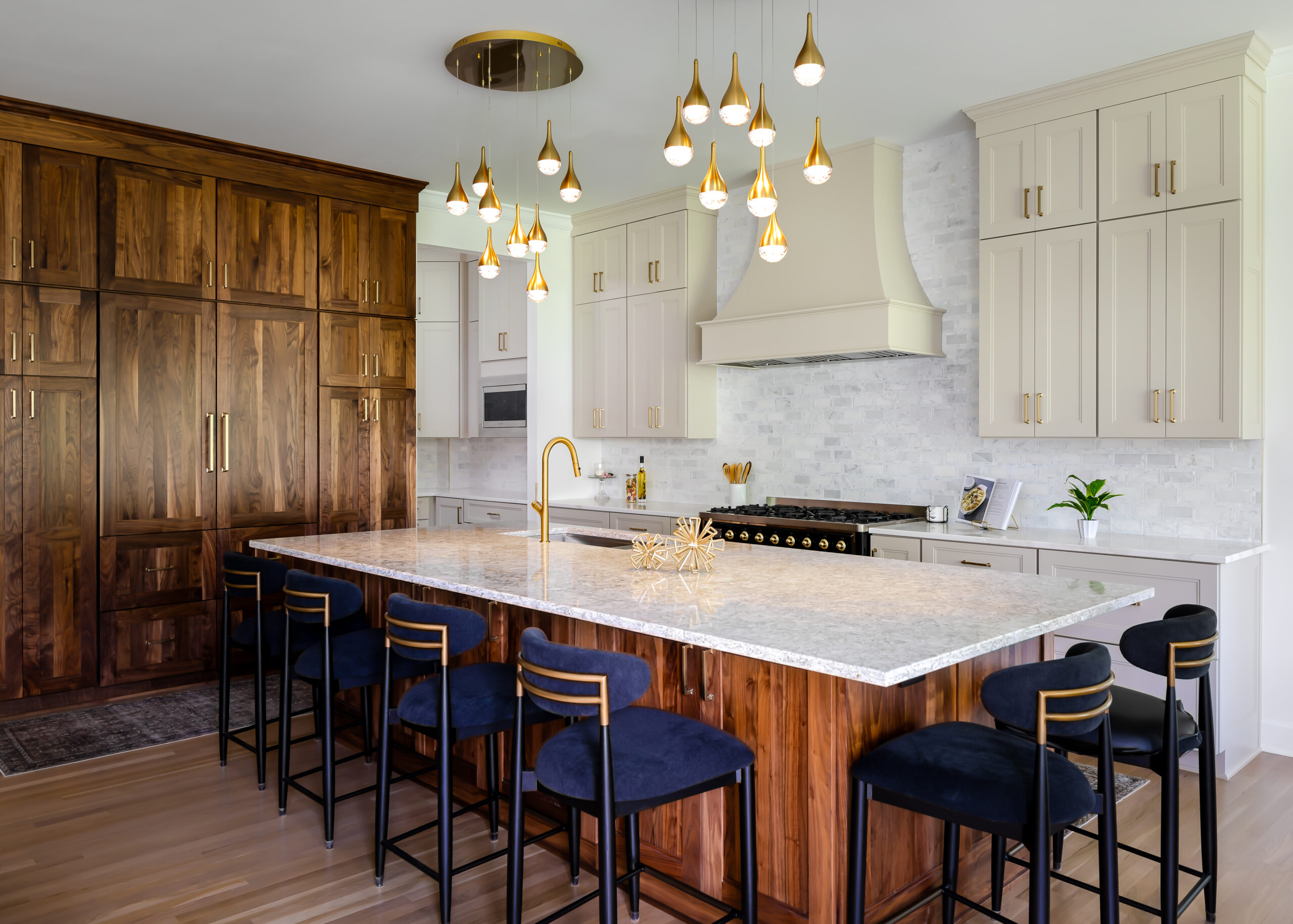Are you considering a splash of style and durability for your kitchen countertops? Ceramic tile is a compelling choice! Our comprehensive guide will equip you with everything you need about ceramic tile countertops. We’ll delve into the cleaning process, explore if ceramic tile is the perfect fit for your kitchen’s hustle and bustle, and answer the burning question: can you place hot pots and pans directly on the tile surface? Let’s dive in and explore the world of ceramic tile countertops!
Ceramic Tile Countertop Guide: Your Questions Answered
Whether you’re considering a full kitchen remodel or simply need some maintenance tips, Karin Ross Designs answers major questions on ceramic tile countertops below.
Is Ceramic Tile Good for Kitchen Countertops?
Ceramic tile countertops are excellent for kitchens because of their durability, beauty, and endless design choices. Below is a breakdown of the pros and cons of ceramic tile countertops for kitchens:
Pros:
Some major benefits of using ceramic tile on kitchen countertops include:
- Durable: Ceramic tile is highly resistant to heat, scratches, and stains, making it a good choice for busy kitchens.
- Affordable: Compared to some other countertop materials like granite or quartz, ceramic tile is a budget-friendly option.
- Variety: With a vast array of colors, patterns, and finishes, ceramic tile offers great design flexibility to match any kitchen style.
- Easy Maintenance: Ceramic tile itself is generally easy to clean with regular wiping and occasional disinfecting.
Cons:
Some cons of ceramic kitchen countertop tiles to consider include:
- Grout Lines: The grout lines between tiles can be susceptible to staining and require regular cleaning to prevent mildew growth.
- Chipping: While generally durable, ceramic tile can chip or crack if it’s hit or impacted by a heavy object.
- Uneven Surface: Grout lines can create an uneven surface on countertops that some find uncomfortable for chopping or kneading dough.
Overall, ceramic tile can be a good choice for kitchen countertops for those who prioritize durability, affordability, and design customization. However, if you often drop heavy objects or prefer a perfectly smooth surface, another material might be a better fit.
Recommended Grout Size and Type
Considering that grout is such a major aspect of tile kitchen countertops, our kitchen remodelers in Kansas City share a breakdown of grout size and type to help you decide:
Grout Size:
For kitchen countertops, the recommended grout size typically falls between 1/16 inch (1.5 mm) and 1/8 inch (3 mm).
- Smaller Grout Lines (1/16″) offer a more modern, seamless look. However, they require a more precise tile installation and may be more prone to cracking if the subfloor isn’t perfectly flat.
- Larger Grout Lines (1/8″) provide more wiggle room for tile variations during installation and are less likely to crack. They can also be easier to clean, especially with a sanded grout option.
Grout Type:
- Sanded Grout: A good choice for grout lines wider than 1/8 inch (3 mm) as the sand fills the gaps and creates a stronger structure. However, the sand can scratch some glazed tile surfaces.
- Non-Sanded Grout: Ideal for grout lines 1/8 inch (3 mm) or smaller and for smoother glazed tiles that might scratch with sanded grout. It offers a smoother finish but may require more frequent cleaning due to its finer texture.
Additional Considerations:
- Epoxy Grout: This high-performance option is especially resistant to stains and mildew, making it ideal for kitchens.
- Grout Color: Darker grout colors tend to hide stains better than lighter ones. However, they can also make any imperfections in the tile layout more noticeable.
Grout Line Size | Grout Type | Pros | Cons |
1/16 inch (1.5 mm) | Non-Sanded | Seamless look, ideal for smooth tiles | Requires precise installation, may show dirt more easily |
1/8 inch (3 mm) | Sanded or Non-Sanded | Easier installation hides imperfections, easier to clean (Sanded) | Can scratch some tiles (Sanded) |
– | Epoxy | Stain and mildew-resistant | Most expensive, requires skilled installation |
Making design choices for your kitchen that you will love for years to come can be overwhelming. However, our professional Kansas City interior designer can help you determine the best type of countertop, grout size, and grout type for your specific project. Ask Karin Ross about your project ideas and schedule a design consultation today.
Can You Put Hot Things on Tile Countertops?
Yes, you can put hot things on ceramic tile countertops. However, it’s best to use a trivet or hot pad to protect your countertops. Although ceramic tiles are heat resistant, excessive exposure to heat can still cause damage over time. For instance, regularly placing hot pans in the same spot can cause discoloration. Thermal shock, which occurs when a cold surface is suddenly heated, can also cause cracking. As such, be mindful of where and how often you’re placing hot things on your ceramic tile kitchen countertops.
Keeping Your Ceramic Canvas Sparkling: How to Clean Ceramic Tile Countertops
The beauty of ceramic tile countertops lies not just in their aesthetics but also in their relative ease of cleaning. Here’s a guide to keeping your ceramic countertop gleaming:
Daily Cleaning:
- Warm water and dish soap: For everyday cleaning, a simple mixture of warm water with a few drops of mild dish soap is all you need. Use a microfiber cloth to wipe down the surface, rinsing the cloth frequently to avoid spreading dirt.
- Disinfecting wipe (optional): A quick way to disinfect your tile countertops, especially after handling raw food, is to use a disinfectant wipe specifically designed for kitchen countertops.
Weekly Deep Cleaning:
- Vinegar solution: A vinegar solution of equal parts white vinegar and water in a spray bottle is excellent for tougher grime or messes. Lightly spray the countertop, let the solution sit for a few minutes, then wipe clean with a damp microfiber cloth. Note: Avoid using vinegar on heavily colored grout or natural stone surfaces, as it can be acidic and cause dullness.
For Stubborn Stains:
- Baking soda paste: For stuck-on food or other stubborn stains, create a paste with baking soda and water. Apply the paste to the stain, let it sit for 15 to 20 minutes, then scrub gently with a soft sponge or brush. Rinse the area thoroughly and dry with a clean cloth.
More General Cleaning Tips:
- Avoid harsh chemicals: Avoid using abrasive cleaners, bleach, or ammonia, as these can damage the tile surface or grout.
- Address spills immediately: The sooner you clean up spills, the less likely they are to stain the tile or grout.
- Dry thoroughly: Don’t leave your countertops wet for extended periods, as this can lead to water spots or mildew growth, especially in the grout lines.
- Regular grout cleaning: To prevent mildew buildup, you may need to clean your grout lines more frequently, especially in areas that tend to be more humid. A paste of baking soda and hydrogen peroxide can be effective for deep-cleaning grout.
By following these simple cleaning tips for ceramic tile countertops, you can ensure yours stays beautiful and hygienic for years to come.
The Final Touch: Your Dream Kitchen Awaits
Ceramic tile countertops offer a perfect blend of style, functionality, and affordability for your kitchen. With proper care and cleaning, they’ll continue to grace your space for years to come. If you’re considering a kitchen remodel and are captivated by the endless possibilities of ceramic tile, look no further! Karin Ross Designs, a renowned Kansas City interior design and remodeling company in Kansas City, can help you translate your vision into a stunning reality.
Contact Karin Ross Designs today, and let’s create your dream kitchen masterpiece!










